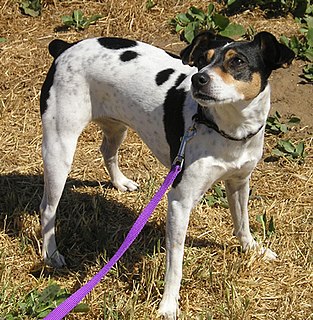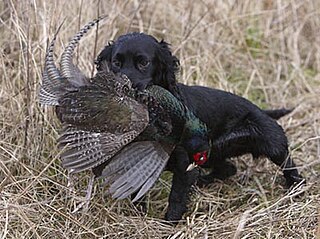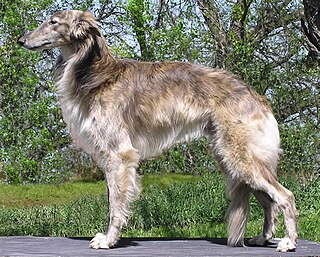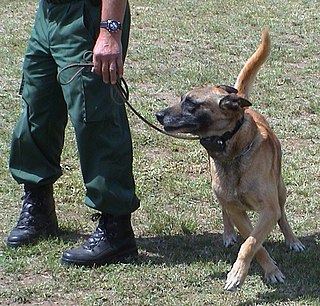
The border collie is a working and herding dog breed developed in the Scottish borders for herding livestock, especially sheep. It was specifically bred for intelligence and obedience. They are very fetch oriented.

Schutzhund is a dog sport that was developed in Germany in the early 1900s as a breed suitability test for the German Shepherd breed. The test would determine if the dog displayed the appropriate traits and characteristics of a proper working German Shepherd. Today, it is used as a sport where many breeds other than German Shepherd Dogs can compete, but it is such a demanding test that few dogs can pass.

A hearing dog is a type of assistance dog specifically selected and trained to assist people who are deaf or hard of hearing by alerting their handler to important sounds, such as doorbells, smoke alarms, ringing telephones, or alarm clocks. They may also work outside the home, alerting their handler to sounds such as sirens, forklifts, and a person calling the handler's name.

A herding dog, also known as a stock dog, shepherd dog or working dog, is a type of pastoral dog that either has been trained in herding or belongs to breeds that are developed for herding.

Gun dogs, or bird dogs, are types of hunting dogs developed to assist hunters in finding and retrieving game, usually birds. Gun dogs are divided into three primary types: retrievers, flushing dogs, and pointing breeds.

The Groenendael is a variety of dog that is included in the Belgian Shepherd breed, but sometimes treated as a distinct breed. The Groenendael is recognized, either as a breed or a variety of the larger breed, by all major kennel clubs, such as the Kennel Club of the UK. In the American Kennel Club, it is called the Belgian Sheepdog, a term otherwise synonymous with Belgian Shepherd Dog more broadly.

A leash is a rope or similar material used to control an animal by attaching to it or to a separate object on it; some leashes clip or tie to a collar, harness, or halter, while others go directly around the animal's neck or head.
An obedience school is an institution that trains pets how to behave properly. When puppies are young and in the first stages of training, they are often taken by their owners to obedience schools. Training usually takes place in small groups. In addition to training pets themselves, obedience schools also teach pet owners how to train, praise, and scold their pets themselves. Schools can teach at a various set of levels, ranging from the very basics for puppies to more advanced for competition level dogs. Most training in schools however, focuses on making dogs listen through basic commands such as sit, stay, lie down, etc. Prices for schools range between $1,000 and $2,500.

The Canine Good Citizen (CGC) program, established in 1989, is an American Kennel Club program to promote responsible dog ownership and to encourage the training of well-mannered dogs. A dog and handler team must take a short behavioral evaluation of less than half an hour; dogs who pass the evaluation earn the Canine Good Citizen certificate, which many people represent after the dog's name, abbreviating it as CGC; for example, "Fido, CGC".

Dog training is the application of behavior analysis which uses the environmental events of antecedents and consequences to modify the behavior of a dog, either for it to assist in specific activities or undertake particular tasks, or for it to participate effectively in contemporary domestic life. While training dogs for specific roles dates back to Roman times at least, the training of dogs to be compatible household pets developed with suburbanization in the 1950s.

A halter or headcollar is headgear that is used to lead or tie up livestock and, occasionally, other animals; it fits behind the ears, and around the muzzle. To handle the animal, usually a lead rope is attached. On smaller animals, such as dogs, a leash is attached to the halter.
A dog collar is a piece of material put around the neck of a dog. A collar may be used for restraint, identification, fashion, or protection. Identification tags and medical information are often placed on dog collars. Collars are often used in conjunction with a leash for restraining a dog. Collars can be traumatic to the trachea if the dog pulls against the restraint of the leash, causing severe pressure to the neck. Conversely, dogs may easily slip out of collars that are too loose. These problems can be avoided by using a dog harness in lieu of a collar, yet collars are still more commonly used.

The Portuguese Podengo is hound breed from Portugal. As a breed, the Podengo is divided into three size categories that are not interbred: small (Pequeno), medium (Médio) and large (Grande). Their coats are either short and 'smooth', or longer and 'wired'. The smooth coated variety is traditional, whereas the wire coated variety is an outcome of the assimilation of various other breeds during the 20th century. In general, the breed is healthy; the Pequeno (small) variety has an average lifespan of approximately 15–17 years.

The use of dogs in search and rescue (SAR) is a valuable component in wilderness tracking, natural disasters, mass casualty events, and in locating missing people. Dedicated handlers and well-trained dogs are required for the use of dogs to be effective in search efforts. Search and rescue dogs are typically worked, by a small team on foot.
An obedience trial is a dog sport in which a dog must perfectly execute a predefined set of tasks when directed to do so by his handler. According to the American Kennel Club (AKC) obedience regulations
The basic objective of obedience trials, however, is to recognize dogs that have been trained to behave in the home, in public places, and in the presence of other dogs, in a manner that will reflect credit on the sport of obedience at all times and under all conditions.

A hunt test is an event at which the natural ability and training of gun dogs are evaluated against a written standard. Each dog that meets this standard earns a pass. This is unlike a field trial in which dog/handler teams compete against one another with only one dog being declared the winner.

The Silken Windhound is an American breed of sighthound. Like most sighthounds, Silkens are noted coursers.
Rally obedience is a dog sport based on obedience. It was originally devised by Charles L. "Bud" Kramer from the obedience practice of "doodling" — doing a variety of interesting warmup and freestyle exercises. The doodles were usually parts of obedience exercises that taught the skills and improved performance and accuracy.

A shock collar is any of a family of training collars that deliver electrical shocks of varying intensity and duration to the neck of a dog via a radio-controlled electronic device incorporated into a dog collar. Some collar models also include a tone or vibrational setting, as an alternative to or in conjunction with the shock. Others include integration with Internet mapping capabilities and GPS to locate the dog or alert an owner of his/her whereabouts.

Dog agility is a dog sport in which a handler directs a dog through an obstacle course in a race for both time and accuracy. Dogs run off leash with no food or toys as incentives, and the handler can touch neither dog nor obstacles. Consequently, the handler's controls are limited to voice, movement, and various body signals, requiring exceptional training of the animal and coordination of the handler.



















